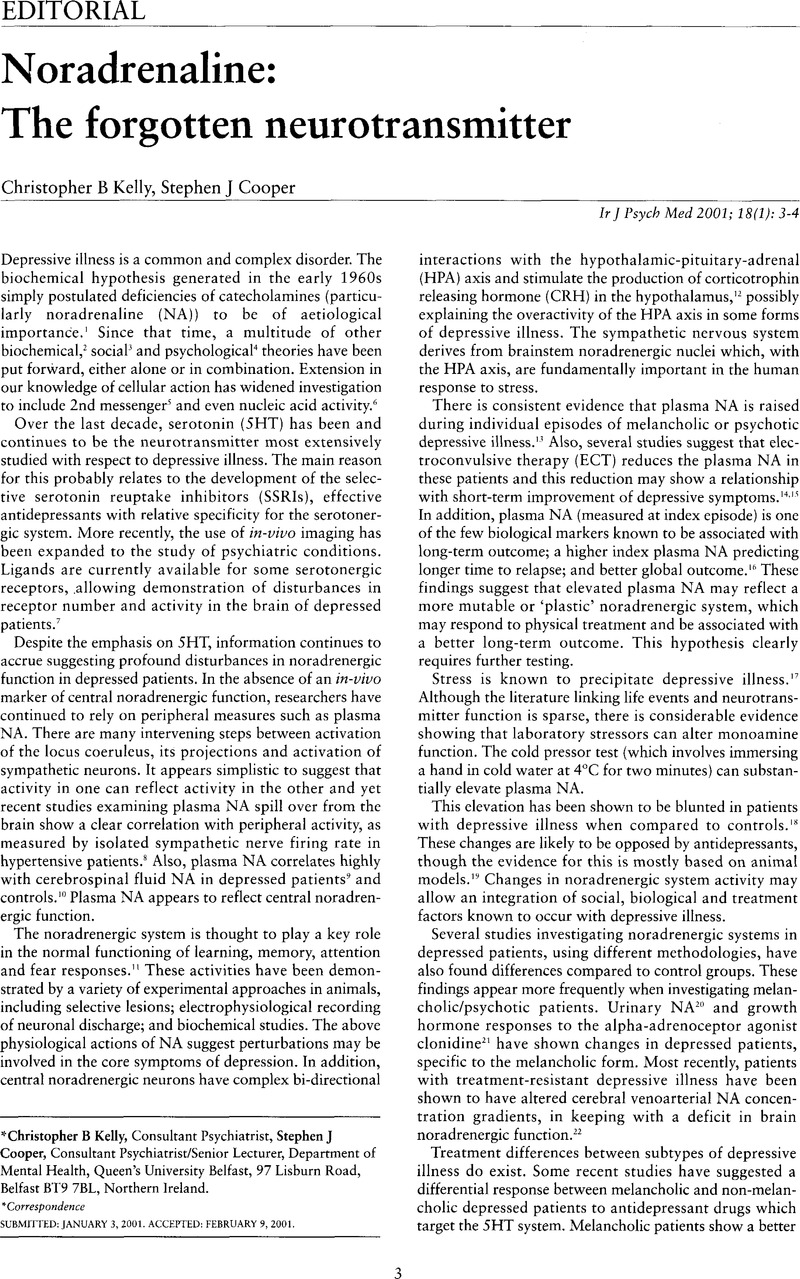No CrossRef data available.
Article contents
Noradrenaline: The forgotten neurotransmitter
Published online by Cambridge University Press: 13 June 2014
Abstract
An abstract is not available for this content so a preview has been provided. As you have access to this content, a full PDF is available via the ‘Save PDF’ action button.

- Type
- Editorial
- Information
- Copyright
- Copyright © Cambridge University Press 2001
References
1.Bunney, WE, Davis, JM. Norepinephrine in depressive reactions. Arch Gen Psychiatry 1965; 13:483–93.CrossRefGoogle ScholarPubMed
2.Cowen, PJ, Wood, AJ. Biological markers of depression. Psychol Med 1991; 21: 831–6.CrossRefGoogle ScholarPubMed
3.Nesse, RM. Is depression an adaptation. Arch Gen Psychiat 2000; 57: 14–20.CrossRefGoogle ScholarPubMed
4.Scott, J. Prevention of depression: psychological and social measures. Advances in Psychiatric Treatment 1995; 1: 94–101.CrossRefGoogle Scholar
5.Coull, MA, Lowther, S, Katona, CLE, Horton, RW. Altered brain protein kinase C in depression: a post mortem study. Eur Neuropsychopharmacol 2000; 10:283–8.CrossRefGoogle ScholarPubMed
6.Veening, JG, Coolen, LM, Spooren, WJet al.Patterns of c-fos expression induced by fluvoxamine are different after acute versus chronic oral administration. Eur Neuropsychopharmacol 1998; 8:213–26.CrossRefGoogle Scholar
7.Sargent, PA, Kjaer, KH, Bench, CJet al.Brain serotonin 1A receptor binding measured by positron emission tomography with [11C] WAY-100635: effects of depression and antidepressant treatment. Arch Gen Psychiat 2000; 57; 174–80.CrossRefGoogle ScholarPubMed
8.Esler, MD, Lambert, GW, Ferrer, Cet al.Central nervous system noradrenergic control of sympathetic outflow in normotensive and hypertensive humans. Clin Exp Hypertens 1995; 17: 409–23.CrossRefGoogle ScholarPubMed
9.Roy, A, Pickar, D, De Jong, Jet al.Norepinephrine and its metabolites in cerebrospinal fluid, plasma and urine. Relationship to hypothalamic-pituitary-adrenal axis function in depression. Arch Gen Psychiat 1988; 45: 849–57.CrossRefGoogle ScholarPubMed
10.Ziegler, MG, Lake, CR, Wood, JH, Brooks, BR, Ebert, MH. Relationship between norepinephrine in blood and cerebrospinal fluid in the presence of a blood cerebrospinal fluid barrier for norepinephrine. J Neurochem 1977; 28: 677–9.CrossRefGoogle ScholarPubMed
11.Fillenz, M. Noradrenergic neurons 1st Ed. Cambridge: Cambridge University Press 1990; 206–28.Google Scholar
12.Brady, LS. Stress, antidepressant drugs and the locus coeruleus. Brain Res Bull 1994; 35: 545–56.CrossRefGoogle ScholarPubMed
13.Kelly, CB, Cooper, SJ. Differences and variability in plasma noradrenaline between depressive and anxiety disorders. J Psychopharmacol 1998; 12: 161–7.CrossRefGoogle ScholarPubMed
14.Kelly, CB, Cooper, SJ. Plasma noradrenaline response to electroconvulsive therapy in depressive illness. Br J Psychiat 1997; 171: 182–6.CrossRefGoogle ScholarPubMed
15.Werstiuk, ES, Coote, M, Griffith, L, Shannon, H, Steiner, M. Effects of electroconvulsive therapy on peripheral adrenoceptors, plasma noradrenaline, MHPG and Cortisol in depressed patients. Br J Psychiat 1996; 169: 758–65.CrossRefGoogle ScholarPubMed
16.Johnston, TG, Kelly, CB, Stevenson, MR, Cooper, SJ. Plasma norepinephrine and prediction of outcome in major depressive disorder. Biol Psychiat 1999; 46: 1253–8.CrossRefGoogle ScholarPubMed
17.Fava, GA, Munari, F, Pavan, L, Kellner, R. Life events and depression. A replication J Affect Disord 1981; 3: 159–65.CrossRefGoogle ScholarPubMed
18.Kelly, CB, Cooper, SJ. Plasma norepinephrine response to a cold pressor test in subtypes of depressive illness. Psychiatry Res 1998; 81: 39–50.CrossRefGoogle ScholarPubMed
19.Anisman, H, Zacharko, RM. Depression: the predisposing influence of stress. Behav Brain Sci 1982; 5: 89–137.CrossRefGoogle Scholar
20.Maes, M, Vandewoude, M, Schotte, C, Blockx, P. Positive relationship between the catecholaminergic turnover and the DST results in depression. Psychol Med 1990; 20: 493–9.CrossRefGoogle ScholarPubMed
21.Checkley, SA, Glass, IB, Thompson, C, Corn, T, Robinson, P. The GH response to clonidine in endogenous as compared with reactive depression. Psychol Med 1984; 14: 773–7.CrossRefGoogle ScholarPubMed
22.Lambert, G, Johansson, M, Agren, H, Friberg, P. Reduced brain norepinephrine and dopamine release in treatment – refractory depressive illness: evidence in support of the catecholomine hypothesis of mood disorders. Arch Gen Psychiatry 2000; 57: 787–93.CrossRefGoogle ScholarPubMed
23.Danish University Antidepressant Group. Paroxetine a selective serotonin uptake inhibitor showing better tolerance but weaker antidepressant effect than clomipramine in a controlled multicentre study. J Affect Disord 1990; 18: 289–99.CrossRefGoogle Scholar
24.Roose, SP, Glassman, AH, Attia, E, Woodring, S. Comparative efficacy of selective serotonin reuptake inhibitors and tricyclics in the treatment of melancholia. Am J Psychiat 1994; 151: 1735–9.Google ScholarPubMed
25.Anderson, IM. Selective serotonin reuptake inhibitors versus tricyclic antidepressants: a meta-analysis of efficacy and tolerability. J Affect Disord 2000; 58: 19–36.CrossRefGoogle ScholarPubMed
26.Davis, R, Wilde, MI. Mirtazepine: a review of its pharmacology and therapeutic potential in the management of major depression. CNS Drugs 1996; 5: 389–402.CrossRefGoogle Scholar
27.Harvey, AT, Rudolph, RL, Preskorn, SH. Evidence of the dual mechanisms of action of venlafaxine. Arch Gen Psychiat 2000; 57: 503–9.CrossRefGoogle ScholarPubMed


